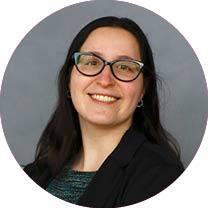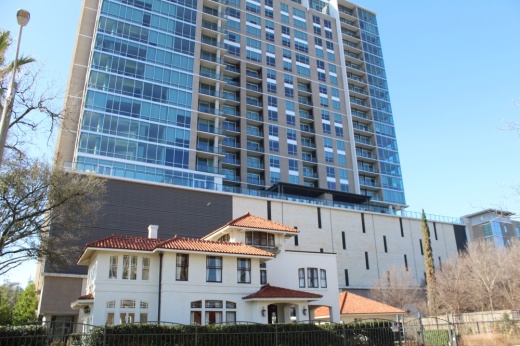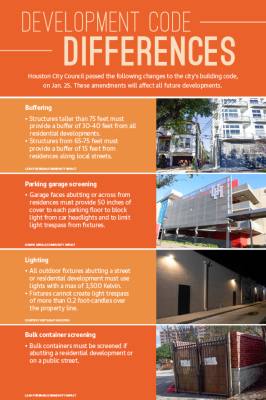Sandy Stevens, president of the Museum Park Neighborhood Association—an organization for residents of the historic Museum Park neighborhood—said she has witnessed construction and development changing her neighborhood. She expressed concern with regards to buffering and lighting issues in her neighborhood, which is situated between Midtown and the Texas Medical Center, bound by Hermann Park, Main Street, Alabama Street and Hwy. 288.
“The most recent development is about 12 stories, right in the middle of the neighborhood,” she said. “And those folks whose properties abut that high-rise have had some real issues with garage lighting.”
This type of development and others across Houston have served as a call to action for residents, which led to buffering ordinance amendments—a years long effort to expand protections for single- and multifamily residents—which passed at Houston City Council on Jan. 25.
These modifications to the city’s code of ordinances entail setting a citywide standard for lighting requirements. The new standard deals with how exterior lighting from residential buildings and commercial construction should be placed as well as a new standard for Kelvin, a measurement used to gauge the color temperature of light bulbs with higher ratings indicating whiter light.
The changes also update requirements for commercial garages to shield residents on shared streets from headlights shining into their homes and made changes to how commercial businesses are allowed to have dumpsters on streets shared with residential properties.
“We really started hearing about some of these complicated relationships between commercial development and residential development when we were working with our Walkable Places and Transit-Oriented Development rules,” said Margaret Wallace Brown, secretary of the city’s Planning and Development Department.
Changes to new developments
Under the changes, high- and mid-rise structures must provide a buffer—or a physical block, such as a fence and landscaping—with 30 to 40 feet in between single- and multifamily and high-rises structures and 15 feet in between single- and multifamily for mid-rises when along local, primarily residential roads. High-rise structures are defined in the ordinance as being above 75 feet tall, while mid-rises are between 65 and 75 feet.
This buffer is meant to provide a physical separation between these differing types of neighboring residential properties, such as through fencing—which is required to be 8 feet tall—and landscaping.
“The benefit of the buffering changes to the residents is multifold. Instead of just protecting single-family homes on larger lots, these amendments will provide protection to all single-family and small multifamily developments when high-rise or mid-rise structures are proposed abutting homes in highly residential areas,” Suvidha Bandi, project manager for the Planning and Development Department, said via email.
These rules will help encourage higher-density developments along major corridors, instead of within neighborhoods, according to Bandi.
Going forward, all garages in the city of Houston that are adjacent to or are across from residential properties must have an external cover of at least 50 inches per floor, across all garage floors, to shield residences from the glare of vehicle headlights. This is 6 inches greater than the city’s previous standard for garage shielding.
Lighting on the exterior of commercial properties on public streets or adjacent to or across from residential developments must have a maximum color temperature of 3,500 Kelvin—a neutral-warm tone—and the light must be housed within the fixture itself to limit glare and light trespass onto neighboring residential properties. Commercial properties must also provide a shield to block out their lighting on property abutting residential developments.
Bulk containers, such as those used for garbage, now must be screened in on all public streets and when adjacent to residential properties.
The community response
Stevens said she believes the ordinances will cause a change in future development.
“I think it will have a significant impact,” she said. “It will make a difference. Will it make as big a difference as some would like? We’ll just have to wait and see.”
Stevens and Debbie Moran, an amateur astronomer who, over the years, has gained knowledge on lighting from organizations such as the International Dark Sky Association, spoke at the Jan. 11 public hearing at Houston City Council’s meeting, after a presentation from Wallace Brown and Bandi from the Planning & Development Department.
Warmer, or less-blue light, allows one to see more at night, according to Moran, who champions her local fight via Softlight Houston.
“The shorter-wavelength light, which is the bluer light, scatters a lot worse. So that’s why we perceive the white headlights and whiter security lights as so much higher glare,” she said. “So if you even have the same wattage of a bulb, if it’s warmer versus cooler or bluer, the blue is going to look a lot more harsh to the eye. And that’s just physics. It’s a short-wavelength light scattering a lot more than the longer-wavelength light.”
Moran also said bluer light is detrimental to melatonin production and to sleep, citing studies from the National Institute of Health and Harvard University.
“For millennia, animals, humans have been keyed in ... to recognize night versus day. And it was not from the absence of all light; it was from the absence of the blue frequency in the light,” she said.
The absence of blue light during nighttime signals the body to produce melatonin, Moran said.
“The harm is multipl[ied] when you add a lot of blue light—and we’re adding a tremendous amount in Houston to the nighttime environment for the human body, and [it] suppresses melatonin,” she said.
Points of debate
Before passing on Jan. 25, this year’s discussion on the ordinance changes began with the Jan. 11 public hearing at City Hall, which spurred debate from the council members.
With regards to the new lighting standards, District K Council Member Martha Castex-Tatum questioned why the commission settled on 3,500 Kelvin versus warmer 3,000 Kelvin lighting.
“We have looked at the whole range and consider 3,000 [Kelvin] the alternative,” Wallace Brown said at the meeting. “However, based on the information that we have gotten from both the Public Works Department and our constituents, our customers have settled on 3,500.”
Castex-Tatum and District J Council Member Edward Pollard both expressed an interest in flexibility for treating cases individually.
Wallace Brown said there is an option in the city’s building code for an alternate method of compliance, which allows for “some flexibility.” Additionally, she said Chapter 42, which relates to subdivisions, developments and platting, allows for some variance requests.
District C Council Member Abbie Kamin noted the changes to residential buffering will not be grandfathered in. Similarly, District I Council Member Robert Gallegos noted concerns over residential developments that are built next to existing commercial garages.
“My concern is if there is nothing there and someone builds a garage and, in time, someone comes in and builds residences across the street, the owner of the garage does not then have to go to these standards,” Gallegos said.
Wallace Brown and Bandi said there is no clause in place to prevent this scenario, and Mayor Sylvester Turner said it is based on the city’s general principle on development: “first in time, first in rank.”
Council members were to vote on the proposed changes at their Jan. 18 meeting but moved it to the following week in order to “allow and provide for variations as specific situations require,” Wallace Brown said.
This ordinance change is the culmination of years of discussions with residents, which began in April 2021, by the Planning Commission and Livable Places Committee. The ordinance changes will take effect 30 days from Houston City Council’s Jan. 25 meeting, on Feb. 25, and will inform all future development.
“How do we build a livable city for all Houstonians so that our residential neighborhoods are convenient to commercial and convenient to the services that we need as residents, but are not unfairly and unjustly harmed by them?” Wallace Brown said.







